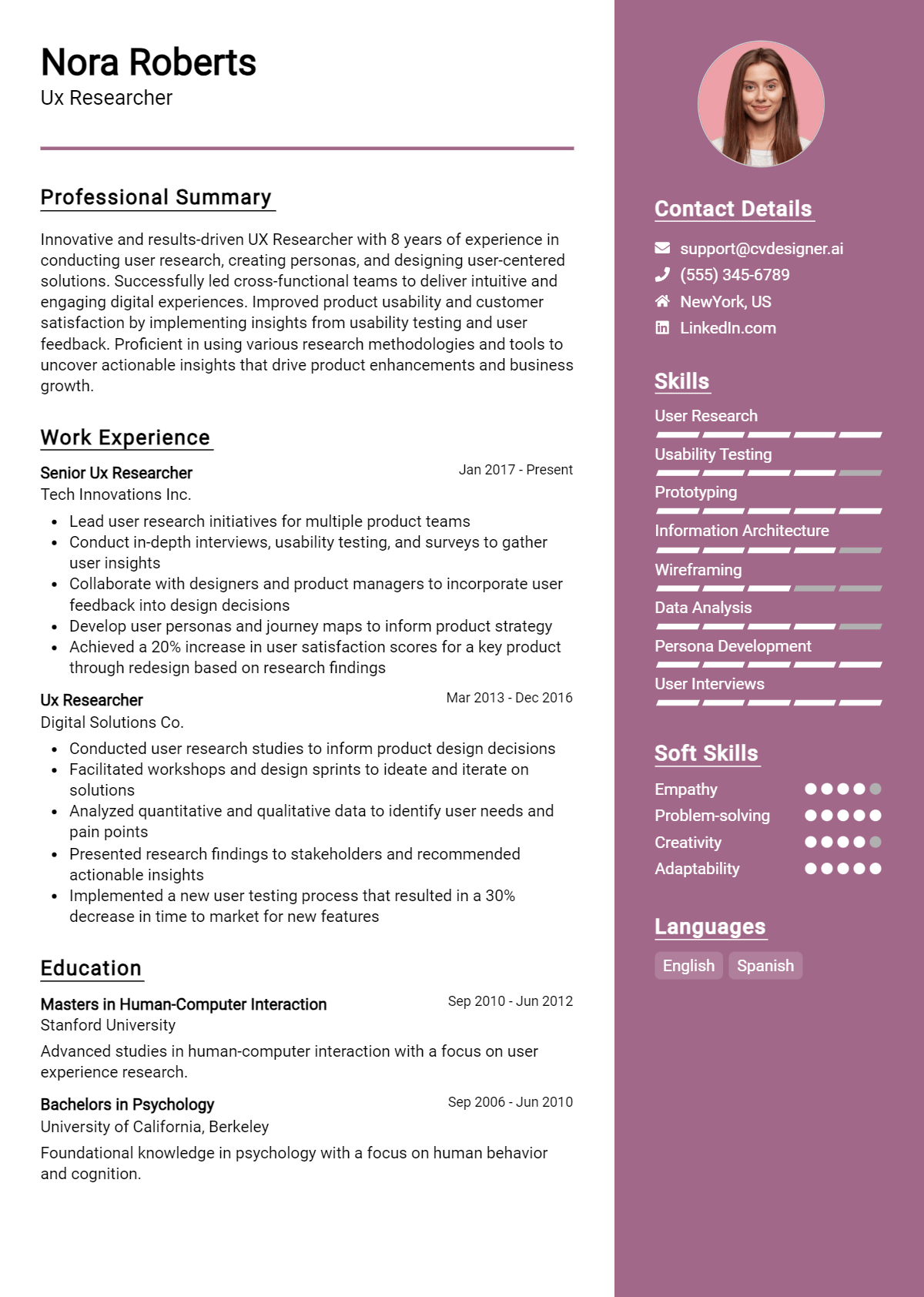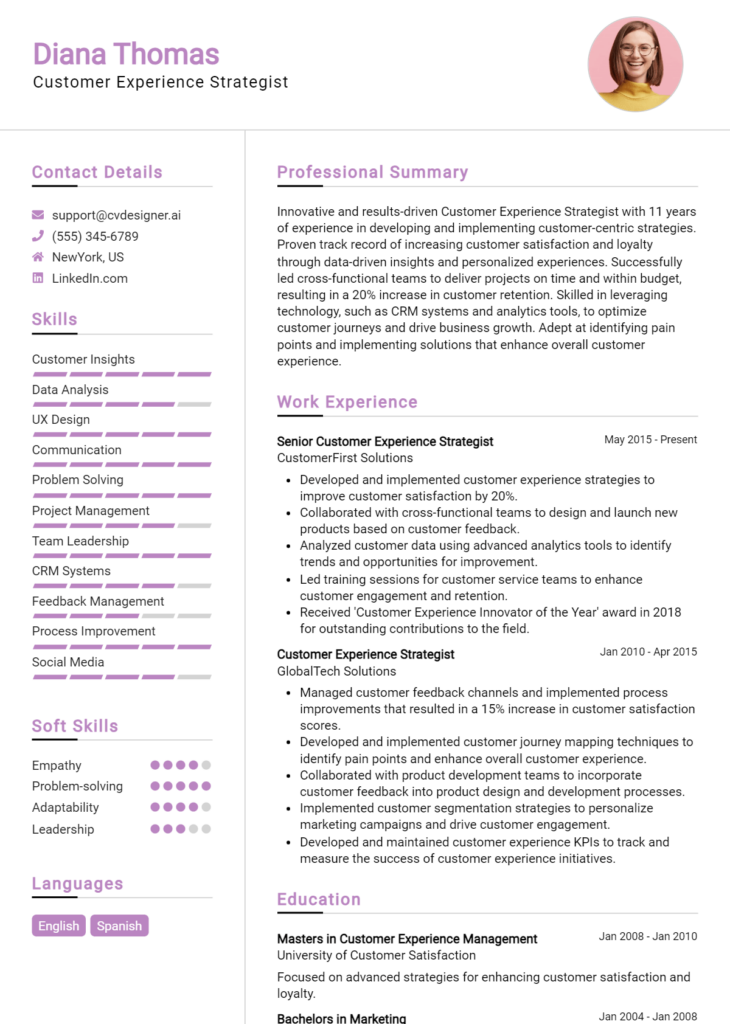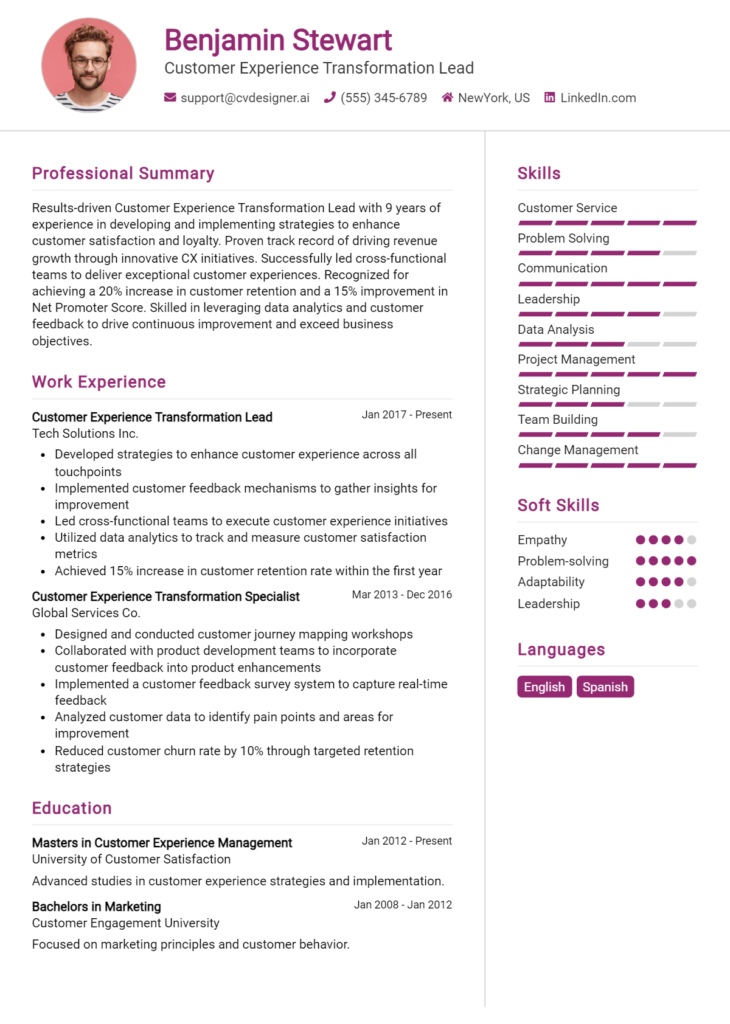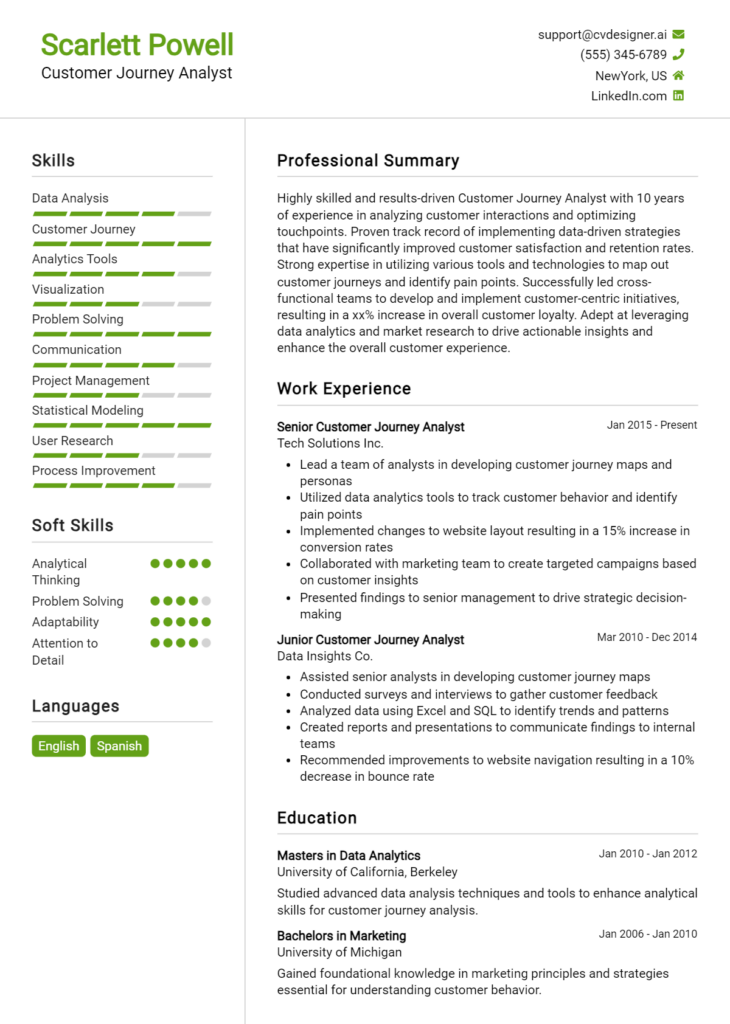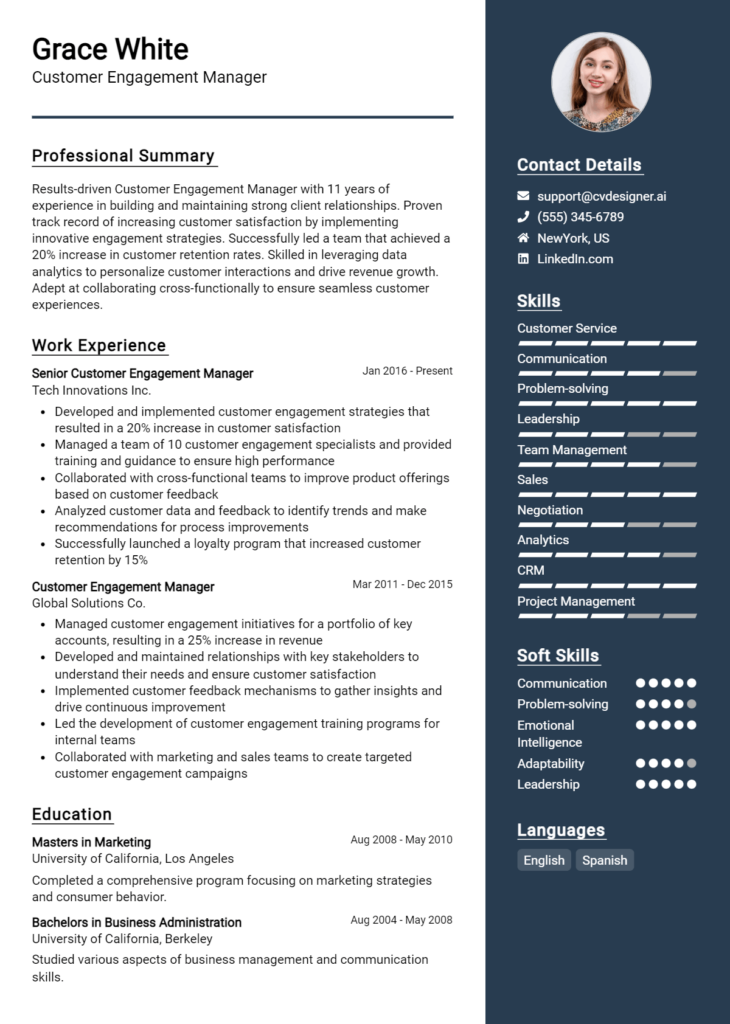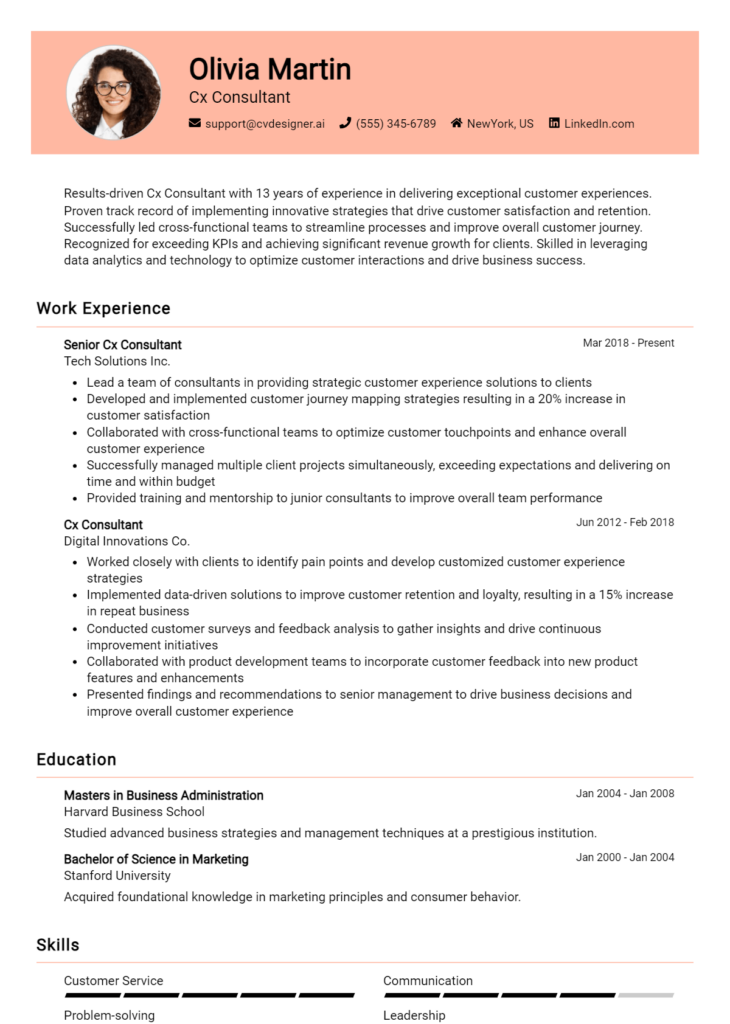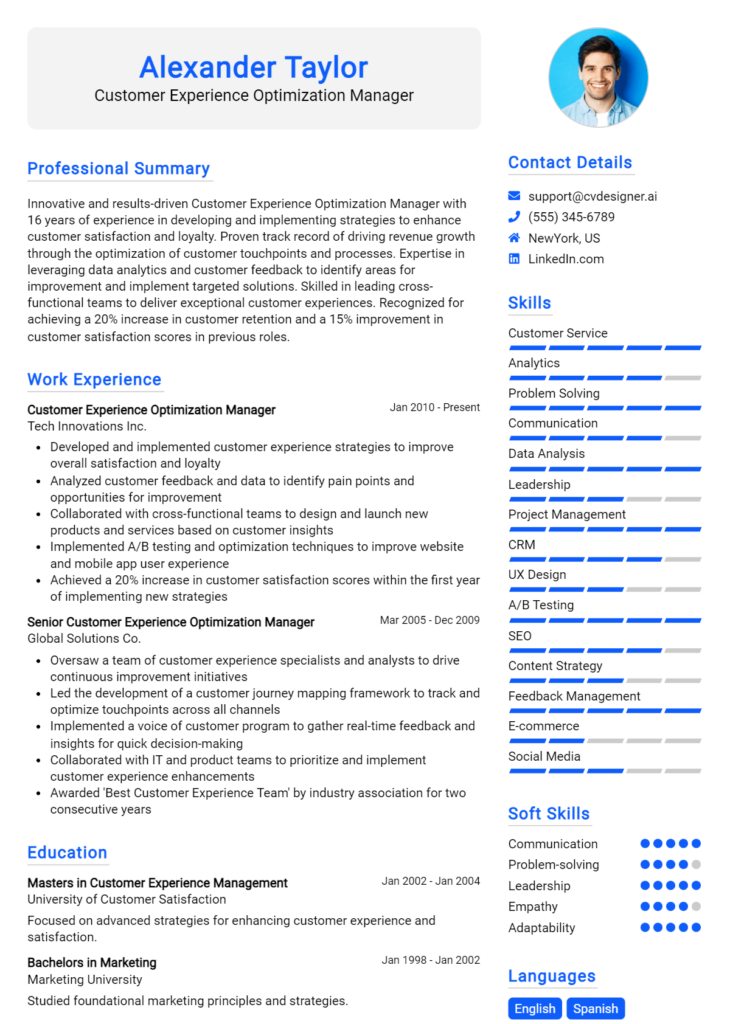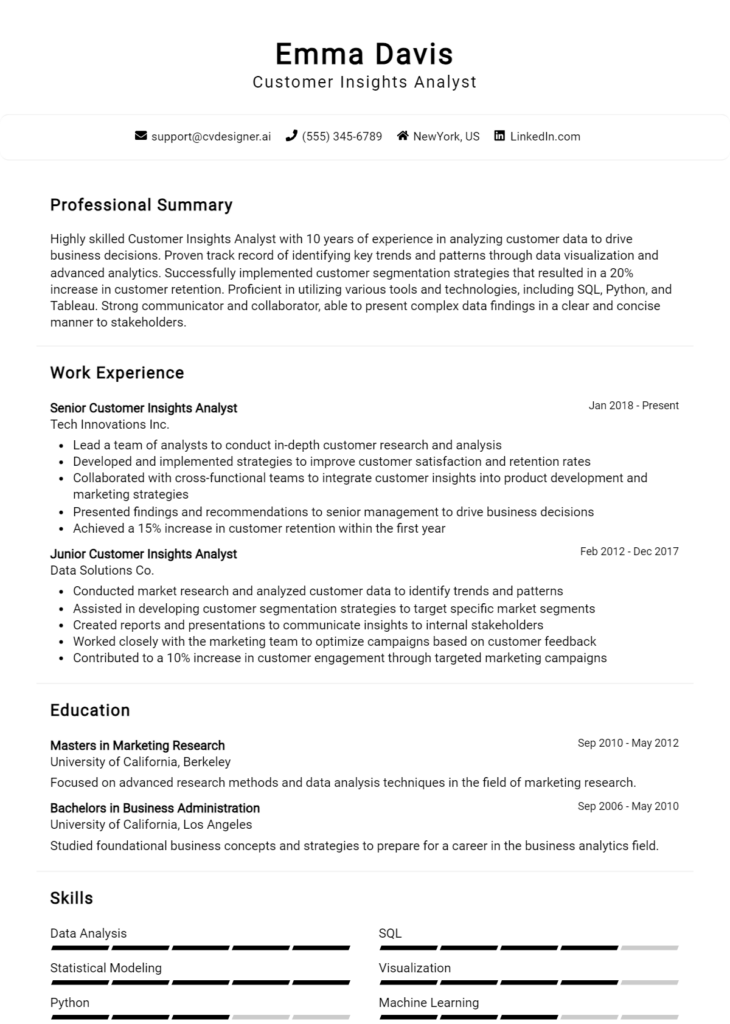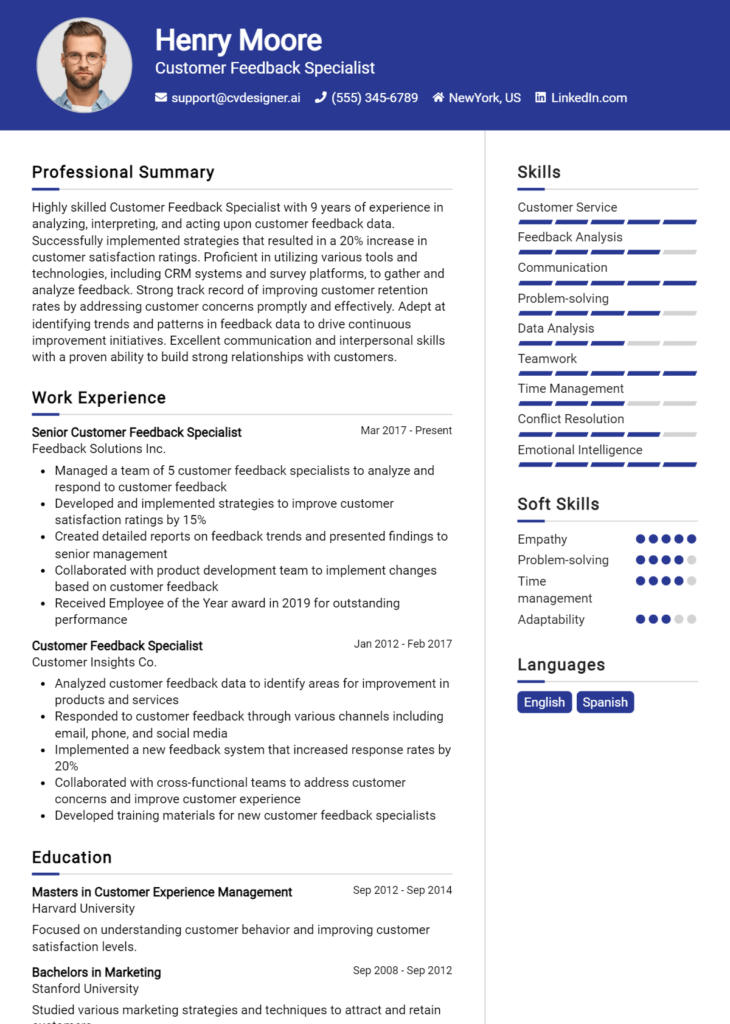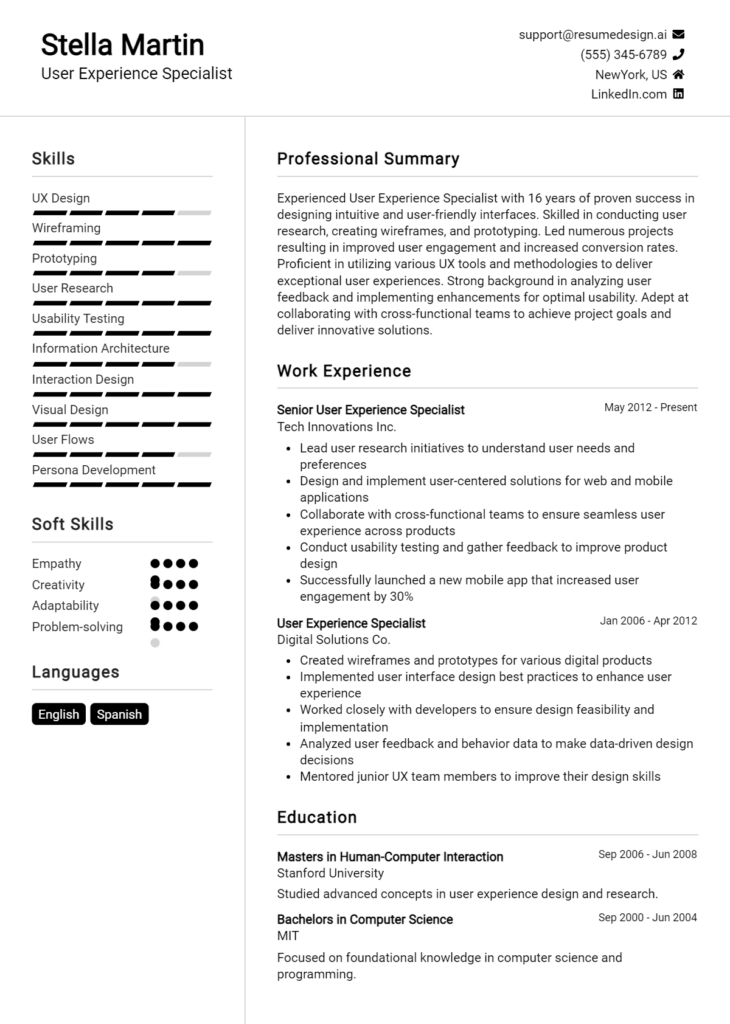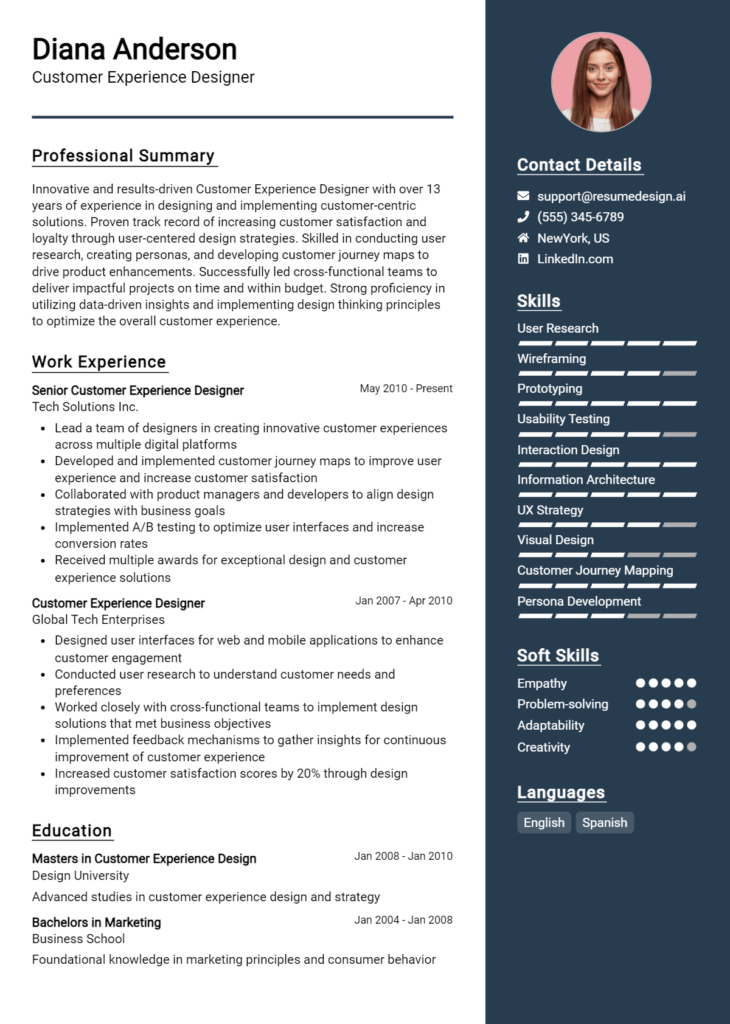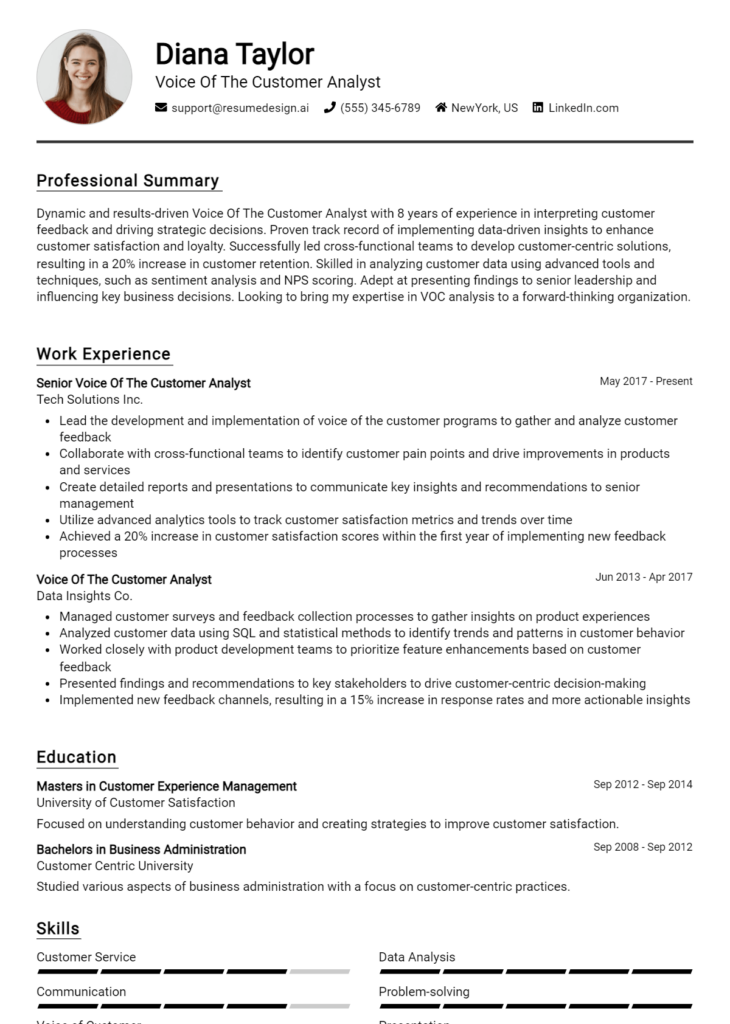UX Researcher Core Responsibilities
A UX Researcher plays a crucial role in bridging design, development, and marketing teams by employing technical, operational, and problem-solving skills to gather user insights. Their responsibilities include conducting user interviews, usability testing, and surveys, which inform product design and enhance user experience. They help align cross-functional teams with user needs, ensuring that organizational goals are met. A well-structured resume showcasing these qualifications can significantly enhance a candidate's appeal to prospective employers.
Common Responsibilities Listed on UX Researcher Resume
- Conduct user interviews and focus groups to gather qualitative feedback.
- Design and execute usability testing sessions to evaluate product interfaces.
- Analyze user data and present findings to stakeholders.
- Create user personas and journey maps to visualize user experiences.
- Collaborate with designers and product managers to refine design concepts.
- Develop and maintain research documentation and reports.
- Identify user needs and pain points through competitive analysis.
- Facilitate workshops to gather insights from cross-functional teams.
- Utilize various research methodologies, including surveys and A/B testing.
- Stay updated on UX trends and best practices to inform research strategies.
- Advocate for user-centered design principles within the organization.
High-Level Resume Tips for UX Researcher Professionals
In the competitive field of UX research, a well-crafted resume serves as your first and often only opportunity to make a lasting impression on potential employers. It’s not just a document that lists your education and work experience; it's a powerful tool that reflects your skills, achievements, and understanding of user experience principles. A strong resume can effectively communicate your unique value proposition and set you apart from other candidates vying for the same position. This guide provides practical and actionable resume tips specifically tailored for UX Researcher professionals, helping you to create a standout resume that captures attention and showcases your expertise.
Top Resume Tips for UX Researcher Professionals
- Tailor your resume to the specific job description by incorporating relevant keywords and phrases that align with the role.
- Highlight your relevant experience in UX research, including internships, projects, and any freelance work that showcases your skills.
- Quantify your achievements by including metrics and data that demonstrate the impact of your research on user experience and product success.
- Emphasize your familiarity with industry-specific tools and methodologies, such as usability testing, surveys, and user interviews.
- Include a section for technical skills, showcasing your proficiency in UX design software, analytics tools, and prototyping platforms.
- Show your understanding of user-centered design principles by discussing how your research has informed design decisions.
- Incorporate a brief summary or objective statement that clearly outlines your career goals and what you bring to the table as a UX researcher.
- Use a clean, professional layout that reflects your design sensibilities and makes it easy for hiring managers to read and navigate.
- Include links to your portfolio or case studies that showcase your research work and the outcomes of your projects.
By implementing these tips, you can significantly enhance your resume and increase your chances of landing a job in the UX Researcher field. A polished resume not only highlights your skills and experiences but also demonstrates your commitment to the craft and your understanding of the importance of effective communication in user experience. Take the time to refine your resume, and you’ll be better positioned to capture the attention of hiring managers and secure interviews.
Why Resume Headlines & Titles are Important for UX Researcher
In the competitive field of UX research, a well-crafted resume headline or title serves as a critical first impression for potential employers. It not only grabs the attention of hiring managers but also succinctly summarizes a candidate's key qualifications in just a few impactful words. A strong headline should be concise, relevant, and directly related to the specific job being applied for, ensuring that it resonates with the expectations and needs of the employer. By effectively conveying expertise and focus, a powerful resume title can set the stage for a deeper evaluation of a candidate's experience and skills.
Best Practices for Crafting Resume Headlines for UX Researcher
- Keep it concise: Aim for one to two lines that clearly communicate your role and expertise.
- Be role-specific: Tailor the headline to reflect the specific UX researcher position you are applying for.
- Highlight key skills: Include essential skills or tools relevant to UX research, such as usability testing or data analysis.
- Showcase your experience: Mention years of experience or notable achievements that set you apart.
- Use action-oriented language: Start with strong verbs that convey your capabilities, like "Experienced" or "Results-Driven."
- Incorporate industry keywords: Use terminology that aligns with the job description to pass through applicant tracking systems.
- Make it impactful: Craft a headline that leaves a memorable impression, encouraging the reader to learn more about you.
- Avoid jargon: Ensure the language is clear and accessible to those who may not be familiar with specific UX terms.
Example Resume Headlines for UX Researcher
Strong Resume Headlines
"User-Centric UX Researcher with 5+ Years of Experience in Usability Testing and User Interviews"
“Data-Driven UX Research Specialist Skilled in Ethnographic Studies and User Journey Mapping”
“Results-Oriented UX Researcher with a Proven Track Record in Enhancing User Experience for Leading Tech Firms”
Weak Resume Headlines
“UX Researcher Seeking Opportunities”
“Experienced Professional in Design”
The strong headlines are effective because they immediately communicate the candidate's expertise and experience in specific areas of UX research, making it clear why they are a good fit for the role. They use impactful language and relevant keywords that resonate with hiring managers. In contrast, the weak headlines fail to impress because they are vague and generic, lacking the specificity needed to stand out in a competitive job market. They do not provide any insight into the candidate's unique skills, experience, or value proposition, which can lead to missed opportunities.
Writing an Exceptional UX Researcher Resume Summary
A well-crafted resume summary is a critical component for a UX Researcher, as it serves as the first impression hiring managers have of a candidate. A strong summary efficiently encapsulates the candidate's key skills, experiences, and accomplishments relevant to the role, allowing them to quickly assess suitability for the position. It should be concise yet impactful, drawing attention to the unique qualifications that set the candidate apart. Tailoring this summary to the specific job being applied for can further enhance its effectiveness, ensuring that it resonates with the requirements and expectations outlined in the job description.
Best Practices for Writing a UX Researcher Resume Summary
- Quantify achievements to demonstrate impact (e.g., “Increased user satisfaction by 30% through targeted research.”)
- Focus on relevant skills such as usability testing, data analysis, and user-centered design.
- Tailor the summary to align with the job description, highlighting keywords and required competencies.
- Keep it concise, ideally between 2 to 4 sentences.
- Use action verbs to convey a sense of initiative and impact.
- Highlight collaborative experiences that demonstrate teamwork in research settings.
- Incorporate industry-specific language to showcase familiarity with UX trends and tools.
- Showcase a blend of qualitative and quantitative research skills to appeal to a diverse range of employers.
Example UX Researcher Resume Summaries
Strong Resume Summaries
Dynamic UX Researcher with over 5 years of experience in user-centered design, successfully leading projects that improved user engagement by 25% and enhanced overall customer satisfaction ratings. Proficient in usability testing, A/B testing, and qualitative research methodologies.
Results-driven UX Researcher with a proven track record of increasing conversion rates by 40% through comprehensive user research and iterative design processes. Skilled in synthesizing user insights into actionable design recommendations, leveraging tools such as Sketch and Axure.
Experienced UX Researcher with extensive expertise in conducting user interviews and surveys, resulting in a 30% reduction in product development time. Strong analytical skills complemented by a deep understanding of human behavior and design principles.
Weak Resume Summaries
I am a UX Researcher with experience in various projects and skills in research methodologies.
Looking for a UX Researcher position where I can use my skills to help companies improve their products.
The strong resume summaries are effective because they provide specific, quantifiable outcomes tied to the candidate's experience and skills, making them relevant and compelling to hiring managers. They showcase the candidate's direct contributions and expertise, which can lead to further interest. In contrast, the weak summaries are vague and lack concrete details, making it difficult for hiring managers to understand the candidate's potential value, thus diminishing their impact in a competitive job market.
Work Experience Section for UX Researcher Resume
The work experience section of a UX Researcher resume is critical as it serves as a platform to showcase not only the candidate's technical skills but also their ability to manage teams and deliver high-quality products. This section allows potential employers to assess how well the candidate aligns with industry standards and expectations. By quantifying achievements and demonstrating the impact of their work, candidates can effectively illustrate their value and contributions to previous projects. Therefore, it is essential to present this section thoughtfully, emphasizing relevant experiences that highlight both individual capabilities and collaborative efforts.
Best Practices for UX Researcher Work Experience
- Clearly outline your role and responsibilities in each position.
- Quantify your achievements with specific metrics and outcomes.
- Highlight your technical expertise in research methodologies and tools.
- Showcase your ability to collaborate with cross-functional teams.
- Include relevant projects that demonstrate your problem-solving skills.
- Align your experiences with the skills and competencies required in the job description.
- Use action verbs to convey your contributions effectively.
- Tailor your work experience to focus on user-centered design and research impact.
Example Work Experiences for UX Researcher
Strong Experiences
- Led a team of 5 researchers to conduct usability testing on a new mobile application, resulting in a 30% increase in user satisfaction scores.
- Implemented a new survey methodology that improved response rates by 50%, providing valuable insights for product development.
- Collaborated with product managers and designers to redefine user personas, enhancing targeted marketing strategies and increasing conversion rates by 20%.
- Presented research findings to stakeholders, influencing the redesign of key product features that led to a 25% decrease in support tickets.
Weak Experiences
- Worked on various projects related to user research.
- Helped with usability studies and provided feedback.
- Conducted surveys and collected data for the team.
- Participated in team meetings to discuss user experience.
The examples provided highlight a clear distinction between strong and weak experiences. Strong experiences are characterized by specific, quantifiable outcomes and demonstrate a proactive approach to problem-solving, leadership, and collaboration. In contrast, weak experiences lack detail, specificity, and measurable impact, which diminishes the candidate's appeal to potential employers. A well-crafted work experience section should effectively communicate the candidate's contributions and accomplishments in a way that resonates with hiring managers.
Education and Certifications Section for UX Researcher Resume
The education and certifications section of a UX Researcher resume plays a critical role in establishing the candidate's qualifications and expertise in the field. This section not only showcases the candidate's academic background but also emphasizes their commitment to continuous learning through industry-relevant certifications and specialized training. By providing details on relevant coursework, certifications, and any additional training, candidates can significantly enhance their credibility and demonstrate alignment with the specific requirements of the UX Researcher role, making them more appealing to potential employers.
Best Practices for UX Researcher Education and Certifications
- Include only relevant degrees and certifications that directly relate to UX research or design.
- Highlight advanced degrees, such as a Master’s or PhD, to showcase a higher level of expertise.
- List industry-recognized certifications, such as Nielsen Norman Group or Human Factors International, to boost credibility.
- Provide details on specific coursework that aligns with UX research methodologies, usability testing, or user experience design.
- Keep the information concise, using bullet points for easy readability.
- Include any specialized training or workshops attended that are relevant to the field of UX research.
- Ensure that the dates of graduation and certification completion are clearly stated to indicate currency of knowledge.
- Tailor the section to reflect the skills and qualifications that match the job description of the UX Researcher role being applied for.
Example Education and Certifications for UX Researcher
Strong Examples
- M.S. in Human-Computer Interaction, Stanford University, 2021
- Certified Usability Analyst (CUA), Human Factors International, 2022
- Relevant Coursework: User Experience Research Methods, Usability Testing, Information Architecture
- UX Research Bootcamp, Nielsen Norman Group, 2023
Weak Examples
- B.A. in History, University of California, 2015
- Certification in Microsoft Office Suite, 2020
- Online Course: Basic Graphic Design, 2019
- High School Diploma, Graduated 2010
The strong examples are considered effective because they directly relate to the skills and knowledge essential for UX research, showcasing relevant degrees, recognized certifications, and pertinent coursework. In contrast, the weak examples lack relevance to the field of UX research, featuring outdated or unrelated qualifications that do not enhance the candidate’s profile for the role, thereby diminishing their appeal to potential employers.
Top Skills & Keywords for UX Researcher Resume
The role of a UX Researcher is crucial in understanding user needs and enhancing the overall user experience. A well-crafted resume that highlights relevant skills can significantly increase a candidate's chances of standing out in a competitive job market. Skills not only demonstrate an applicant's qualifications but also reflect their ability to effectively gather insights, analyze data, and collaborate with cross-functional teams. By showcasing both hard and soft skills, candidates can provide potential employers with a comprehensive view of their capabilities, ultimately leading to successful job placements.
Top Hard & Soft Skills for UX Researcher
Hard Skills
- User Research Techniques
- Usability Testing
- Data Analysis
- Prototyping Tools (e.g., Sketch, Figma, Adobe XD)
- A/B Testing
- Information Architecture
- Survey Design
- Heatmap Analysis
- Interaction Design
- Wireframing
- User Journey Mapping
- Analytics Tools (e.g., Google Analytics)
- Accessibility Standards
- Affinity Diagramming
- Eye-Tracking Analysis
- Programming Basics (HTML/CSS)
- Design Thinking Methodologies
Soft Skills
- Empathy
- Communication Skills
- Critical Thinking
- Problem-Solving
- Team Collaboration
- Adaptability
- Time Management
- Attention to Detail
- Creativity
- Active Listening
- Stakeholder Management
- Open-mindedness
- Negotiation Skills
- Conflict Resolution
- Cultural Awareness
- Flexibility
- Motivation and Drive
For further guidance on how to effectively incorporate these skills into your resume, and to understand how you can showcase your work experience, consider utilizing the links provided for in-depth insights.
Stand Out with a Winning UX Researcher Cover Letter
Dear [Hiring Manager's Name],
I am excited to submit my application for the UX Researcher position at [Company Name], as advertised on [Job Board/Company Website]. With a background in human-centered design and extensive experience in qualitative and quantitative research methodologies, I am confident in my ability to contribute to your team and help create user experiences that are not only intuitive but also deeply engaging. My passion for understanding user behavior and translating insights into actionable design recommendations aligns perfectly with [Company Name]'s commitment to innovative and user-focused solutions.
In my previous role at [Previous Company Name], I successfully led multiple research initiatives that significantly improved the user experience across various digital platforms. By employing methods such as user interviews, usability testing, and A/B testing, I gathered valuable insights that informed product design and strategy. For instance, my research on user interaction patterns resulted in a 30% increase in user engagement for a key product feature. I thrive in collaborative environments and enjoy partnering with cross-functional teams, including designers, product managers, and developers, to ensure that user research informs every stage of the design process.
I am particularly drawn to [Company Name] because of its dedication to creating innovative solutions that prioritize user needs. I admire [specific project, value, or aspect of the company], and I believe my skills in synthesizing data into compelling narratives will enhance your team’s efforts. I am eager to bring my expertise in user research to [Company Name] and contribute to projects that not only meet business goals but also elevate the user experience to new heights.
Thank you for considering my application. I look forward to the opportunity to discuss how my background and skills align with the needs of your team. I am excited about the possibility of contributing to [Company Name] and helping to shape user experiences that resonate with your audience.
Sincerely,
[Your Name]
[Your LinkedIn Profile]
[Your Phone Number]
[Your Email Address]
Common Mistakes to Avoid in a UX Researcher Resume
When crafting a resume for a UX Researcher position, it’s crucial to present your skills, experience, and insights effectively. However, many applicants make common mistakes that can undermine their chances of landing an interview. Avoiding these pitfalls can significantly enhance your resume's impact and demonstrate your suitability for the role.
Vague Job Descriptions: Failing to provide specific details about your previous roles can make it difficult for employers to assess your experience. Be clear about your responsibilities and achievements.
Ignoring UX Methodologies: Not mentioning the specific UX research methods you are familiar with (e.g., usability testing, surveys, interviews) can leave a gap in understanding your expertise.
Lack of Quantifiable Results: Simply stating that you conducted research is not enough. Highlight measurable outcomes, such as improved user satisfaction percentages or increased conversion rates.
Overly Technical Language: Using jargon or overly complex terminology can alienate hiring managers. Ensure your resume is accessible and clearly articulates your skills and experiences.
Not Tailoring the Resume: Submitting a generic resume that doesn’t align with the specific job description can hurt your chances. Customize your resume to reflect the skills and experiences that are most relevant to the position.
Neglecting Soft Skills: While technical skills are important, UX research also requires strong communication and collaboration abilities. Be sure to highlight these soft skills in your resume.
Omitting a Portfolio Link: A UX Researcher’s resume should always include a link to a portfolio showcasing your research projects and findings. This provides tangible evidence of your work and capabilities.
Ignoring Design Principles: As a UX Researcher, presenting a visually appealing resume that follows basic design principles can demonstrate your understanding of good user experience. Avoid cluttered layouts and ensure readability.
Conclusion
In conclusion, a well-crafted UX Researcher resume is essential for standing out in a competitive job market. Throughout this article, we discussed the importance of showcasing relevant skills such as user empathy, research methodologies, and data analysis. Highlighting your experience with usability testing, user interviews, and design thinking processes can significantly enhance your resume's appeal. Additionally, don't forget to tailor your resume for each job application, emphasizing the skills and experiences that align most closely with the specific role.
To ensure your resume makes a lasting impression, we encourage you to take advantage of available resources. Explore resume templates to find a design that suits your style, utilize the resume builder for an easy and efficient creation process, and check out resume examples to gain inspiration from successful UX Researchers. Lastly, consider using cover letter templates to complement your application and further demonstrate your passion for the field. Now is the perfect time to review and refine your UX Researcher resume—take these steps to set yourself apart and increase your chances of landing that desired role!

